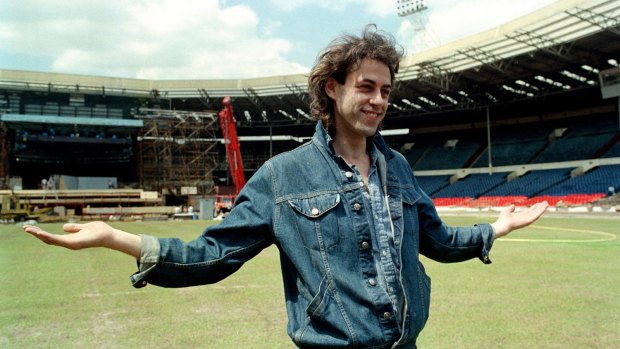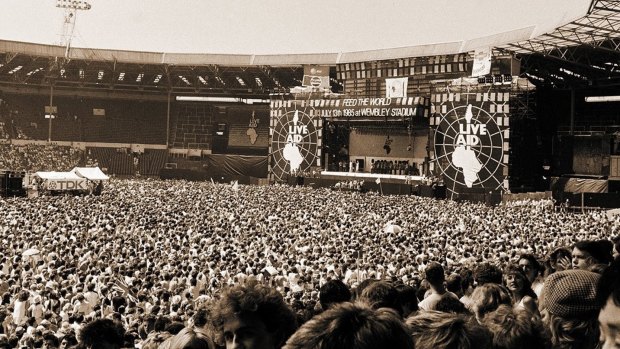By Bernadette McNulty
It's 30 years since Live Aid. You'd be forgiven for thinking it was longer.
Do They Know It's Christmas?, the charity single that led to the concert, feels like it has been remade at least 73 times since 1984, with diminishing returns.

Charity crusader Bob Geldof at Wembley Stadium during preparations for Live Aid in 1985. Credit: AP
Last year's version, by Band Aid 30, successfully raised more millions, this time for the Ebola epidemic in West Africa, but it was dogged by a sense of increasing discomfit about whether white Western pop stars singing about feeding the world was the best way to help humanitarian crises on another continent.
Organiser Sir Bob Geldof was forced to admit that everyone was sick of the song and it was probably the last time they should do it.

Game-changing Live Aid in 1985.
The 1985 Live Aid concert, held six months after the Christmas single was released, has been repeated only once, in 2005. Rebranded and scheduled to coincide with the G8 conference on global poverty, Live8 was arguably an even bigger deal than Live Aid, with 10 simultaneous global concerts, compared with the original's two, and broadcast to double the audience: 3 billion people around the world.
Yet I dare you to name one standout performance from it: Madonna, perhaps, mostly because she was wearing that funny white waistcoat? Elton John and Pete Doherty's unusual interpretation of Children of the Revolution, possibly?
Even Geldof admitted last year that "people don't really remember Live8, and that was far bigger".
Best not to even try to recall Farm Aid or Live Earth then.
No matter how far in the distant past, one thing Live Aid wasn't was forgettable. Along with the wedding of Charles and Diana and the fall of the Berlin Wall, the event was one of the TV landmarks of the '80s.
I remember the excitement of shutting the curtains against the hot sun and just watching the box for the rest of the day. It was like Christmas, only better.
Even in that indulgent reverie back then, it was not a flawless concert, littered with dodgy moments – Adam Ant's shambling turn, Simon Le Bon's bum note, the sound cutting out on Paul McCartney – but compared to most music broadcasts it had the sense of something real and more intensely "live" than any concert that had been shown on TV before.
There was the thrill to the constant sense of uncertainty and the unscripted happening: Princess Diana forcing Prince Charles into some awkward dancing, Geldof losing his rag and demanding our money, Mick Jagger ripping away Tina Turner's dress.
But mostly it was the performances that cracked through the screen, particularly Queen and U2. No matter how mainstream the programme was designed to be, it bristled with a very British, almost punkish amateurism.
In some ways, it seems like it was the final fanfare of the music industry at its most imperial, typified by Noel Edmonds – the Chris Evans of his day – dropping Phil Collins off in a helicopter so he could fly on Concorde to Live Aid's other concert that day in Philadelphia.
Adam Ant has subsequently derided it as the moment rock'n'roll died; a touch of sour grapes, perhaps, but even without giving birth to the industry of charity endorsement and the idea of pop stars as Establishment figures, within the next 10 years the underground sounds of indie, dance and rap music, and the imminent onslaught of the internet, would mean that Live Aid represented one of the final moments when the world seemed in a kind of reverence of pop music and its stars.
Despite many of the performers being in their 20s, the look and feel of '80s pop – big hair and big shoulder pads – made Live Aid feel middle-aged. Bar Madonna, Sade and Tina Turner, you also notice how few women there were, and how white and Anglo-American it all was.
What is equally remarkable is how many of those Live Aid performers are still going, to varying degrees of success. Paul Young, the recipient of the Brit award that year for best male, may have slipped from view, but he is touring at a venue near you this year. Duran Duran are about to release their 18th album. The Rolling Stones are still the biggest live act in the world.
The real star of the Live Aid show, though, was the audience: the deliriously happy crowd at Wembley, clambering on shoulders and pumping their arms in unison to Queen's Radio Gaga; and, by proxy, the millions of us at home, glued to our screens and donating our money. Live Aid created a sense of the magical, transcendent thrill of live music. It's a sensation more of us would go on to chase, especially at festivals.
During Kanye West's Glastonbury headline set last month, the biggest cheer of the night came when he started to sing Bohemian Rhapsody, also a standout moment for Freddie Mercury at Live Aid.
West fluffed it somewhat, but it was a moment when it looked as though the rap star might stop performing and start communing with his audience, the kind of connection that still makes or breaks every single Pyramid stage turn.
We may never see an event like Live Aid again, but the spirit of live music as something magical and life-changing, and our desire to be a part of it, still live on.
Telegraph, London